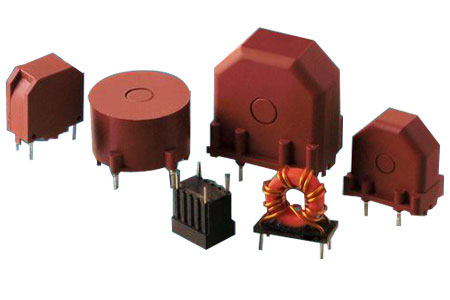Common Mode Chokes
Inductive components with two symmetrical windings. Symmetrical “useful” currents remain almost completely unsuppressed, while asymmetrical “interference” currents are strongly suppressed.
Common mode chokes are used because many electrical devices may be connected to the same power lines (or power supply lines), substantial electrical noise can exist on these lines. Switching mode power supplies can generate a lot of high frequency noise which can travel over the power lines and interfere with the operation of computers and other electronic devices connected to the power lines. Electro-magnetic interference in the environment can induce or couple electrical noise into the power lines. Electrical noise which comes in one power line wire and returns to the noise source through the other power line wire is differential noise. Electrical noise which comes through one power line and returns to the noise source through some type of ground path is common mode noise. It is desirable to filter out the unwanted noise signals without significantly affecting the desired signal.
Environmental sources of E.M.I. often create an independent return path (ground path) for the electrical noise signals. The return path of the desired signal is a different path. Because there are two different return path, a common mode choke can be used to significantly block (hence reduce) the unwanted noise signal (at the load) without significant reduction in the desired signal. Differential and common mode chokes (or inductors) are often placed between electrical (or electronic) equipment and the power lines supplying power to the electrical equipment.
The chokes reduce electrical noise both entering and leaving a piece of electrical equipment. A common mode choke (or filter) is used to reduce common mode (electrical) noise. Common mode chokes can be designed to include some differential filtering thereby eliminating the need for a separate differential choke (or inductor) in some applications. Toroids are the preferred core shape to use in common mode chokes.
The continuous unbroken circular path maximizes magnetic coupling between windings thereby minimizing leakage inductance. "E" cores are the second most preferred core shapes for common mode chokes. The toroids are less costly than the "E" cores, but "E" core bobbins are easier and less costly to wind. Toroidal coils are usually more costly to mount into an assembly. An air gap can be easily placed between "E" core halves. A gapped core has more leakage inductance; hence "E" core structures are usually preferred when some differential filtering is desired from the common mode choke.
Common mode chokes can be made from other core shapes but usually at higher cost. Their use occurs when a special characteristic is needed. For example, an "EFD" core may be used when a low profile is desired. Selecting the optimum core material for common mode chokes is not easy. The frequency range of the electrical noise is the major factor. If only power frequency noise is expected (i.e. 60 Hz. harmonics), then laminated silicon steel may suffice. Laminated nickel iron or powdered iron or "sendust" type powder will do for lower audio range noise frequencies. Perhaps moly-permalloy powders for the upper audio range (depending on noise levels). Ferrite materials are needed for noise frequencies above 20 kHz. Although the inductive value of ferrites diminishes rapidly above 1 megahertz, some ferrite materials are still suitable for common mode chokes because the resistive component helps maintain a sufficiently high impedance value. Our company makes common mode chokes in a wide variety of shapes and sizes with some custom designs.
